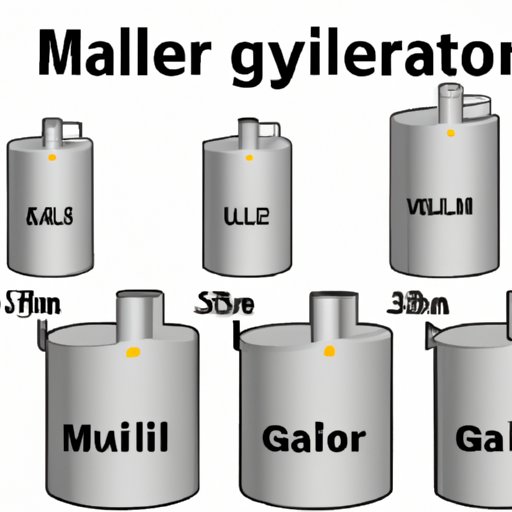Introduction
Gallons and milliliters are both units of measurement that refer to volume. A gallon is a unit of measurement used primarily in the United States, while milliliters, on the other hand, are used as a standard unit of measurement in countries that use the metric system. Converting gallons to milliliters or vice versa is a useful skill to have, especially when it comes to cooking, science, and medicine. This article aims to provide a simple guide to convert gallons to milliliters and vice versa, understand the volume measurements of both units, list down common everyday products measured in these units, and explain their importance in everyday life.
Converting Gallons to Milliliters – A Simple Guide for Daily Use
Converting gallons to milliliters or vice versa is not as difficult as it may sound. To convert gallons to milliliters, simply multiply the number of gallons by 3,785.41. To convert milliliters to gallons, divide the number of milliliters by 3,785.41. It’s that simple!
To make it easier to visualize the conversion process, here’s a table with common conversions:
| Gallons | Milliliters |
|---|---|
| 1 gallon | 3,785.41 milliliters |
| 2 gallons | 7,570.82 milliliters |
| 3 gallons | 11,356.23 milliliters |
| 4 gallons | 15,141.64 milliliters |
| 5 gallons | 18,927.06 milliliters |
With this simple guide, you can now easily convert gallons to milliliters for your everyday use.
Understanding Volume Measurements – The Milliliter and Gallon Explained
Volume measurements are essential in many different contexts, from science to cooking and medicine. A milliliter (mL) is a metric unit of volume that is commonly used for liquid drugs and solvents. On the other hand, a gallon is an imperial unit of volume that is used for liquids, such as milk, gasoline, and water, among others, commonly used in the US.
One US gallon is equivalent to 3.785 liters or 3,785.41 milliliters. The imperial gallon, which is used in the UK, Canada, and other British Commonwealth countries, is different and is equivalent to 4.546 liters.
It’s crucial to understand the difference between milliliters and gallons, especially when working in specialized fields such as science, medicine, or cooking.
10 Everyday Products You Didn’t Know You’re Measuring in Milliliters and Gallons
Many everyday products come in milliliters and gallons, and knowing the conversion values is essential in many situations.
Here’s a list of everyday products that come in milliliters and gallons with their corresponding conversion values:
- Milk: One gallon of milk is equivalent to 3,785.41 milliliters
- Gasoline: One gallon of gasoline is equivalent to 3,785.41 milliliters
- Laundry Detergent: 1.89 liters (half a gallon) of laundry detergent is equivalent to 1,892.71 milliliters
- Water: One gallon of water is equivalent to 3,785.41 milliliters
- Paint: One US gallon of paint is equivalent to 3,785 milliliters
- Juice: One gallon of juice is equivalent to 3,785.41 milliliters
- Beer: One gallon of beer is equivalent to 3,785.41 milliliters
- Vinegar: One gallon of vinegar is equivalent to 3,785.41 milliliters
- Cooking Oil: One gallon of cooking oil is equivalent to 3,785.41 milliliters
- Soda: 101 fluid ounces (roughly 3 liters) of soda is equivalent to 3,000 milliliters
Understanding the measurements of these common everyday products can save you time and prevent errors in measuring quantities.
The Metric and Imperial System: Why Do We Need to Know the Conversion from Gallons to Milliliters?
The world uses two primary systems of measurement – the metric and the imperial system. The metric system is the official measurement system utilized in most parts of the world, while the imperial system is used primarily in the United States, the UK, and a few other countries.
Knowing how to convert gallons to milliliters is essential when working internationally, especially when working in the scientific or commercial fields. It’s crucial to have an understanding of both systems to communicate with colleagues in different countries correctly.
Milliliters and Gallons in Cooking: How to Accurately Measure Ingredients for Your Recipes
Accurate measurements are crucial in cooking to ensure that you get the right results in texture and flavor. Measuring liquids in millimeters and gallons is common, particularly in baking. While cooks generally use a variety of techniques and tools, there are a few standard measurement conversions you should know.
To help you accurately measure ingredients for your recipes, here are a few tips and tricks:
- Convert milliliters to gallons or vice versa by using the conversion of 1 gallon = 3,785.41 milliliters.
- Invest in a precise measuring cup that has both metric and imperial units of measurement.
- Always read the label of the container and use the measurement as provided, do not eyeball it.
- Use a syringe or a dropper to measure small quantities, such as liquids for sauces and dressings.
- Be mindful of table and spoon measurements as they can vary slightly, depending on where they are produced.
By following these tips, you can accurately measure ingredients and get the perfect dish every time.
Conclusion
Overall, converting gallons to milliliters and vice versa is a basic skill that you must have. With this guide, you now have a better understanding of how to convert measurements of these units. Measuring liquids accurately significantly decreases the chance of error, especially in situations such as cooking, where mistakes could lead to poor results. Knowing the conversions of various products, from water to laundry detergent, can help you make informed purchases without overestimating or underestimating the amount of product needed. As you’ve learned, understanding volume measurements and their importance in different fields, such as science or medicine, is essential in today’s ever-globalizing world.
